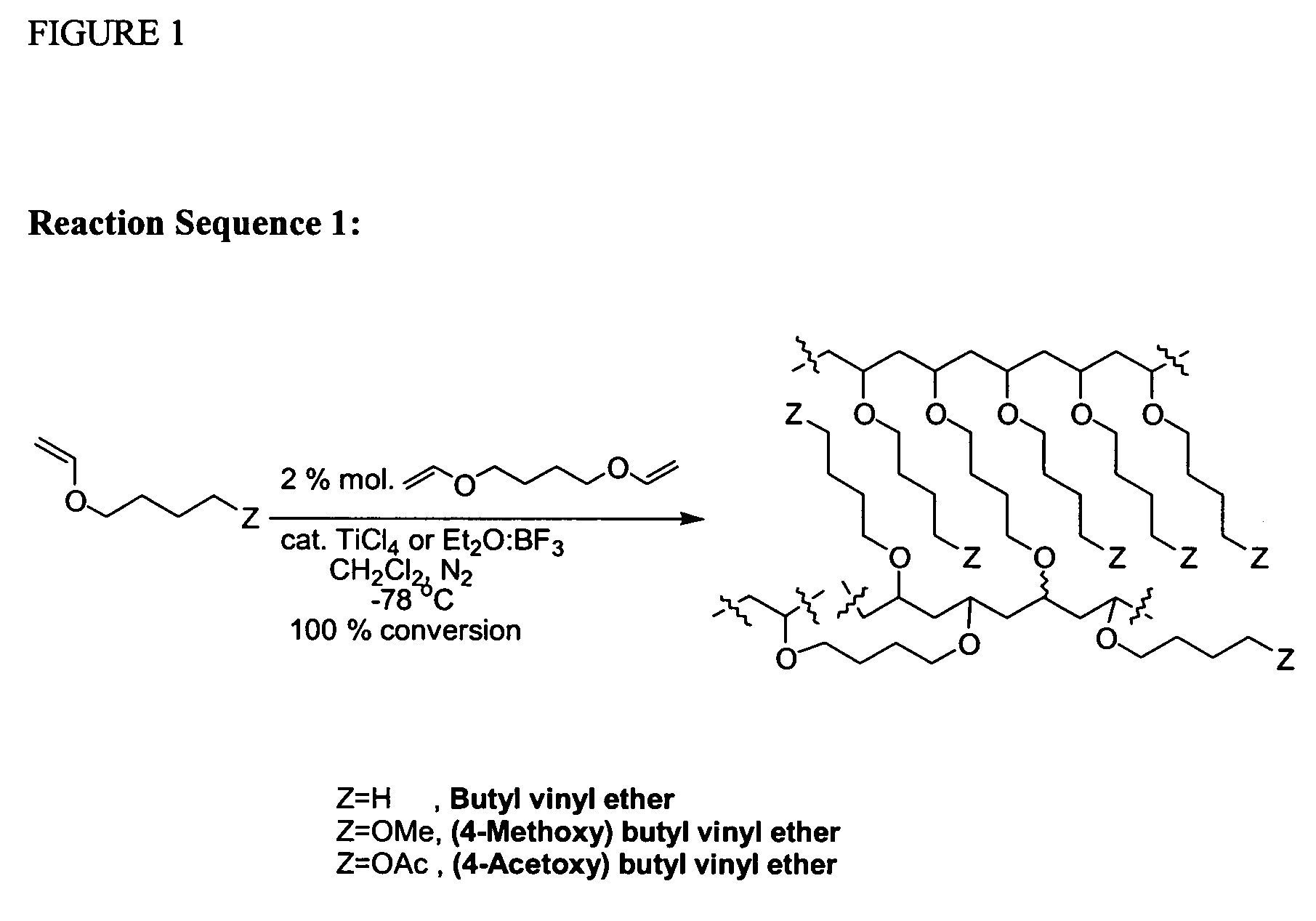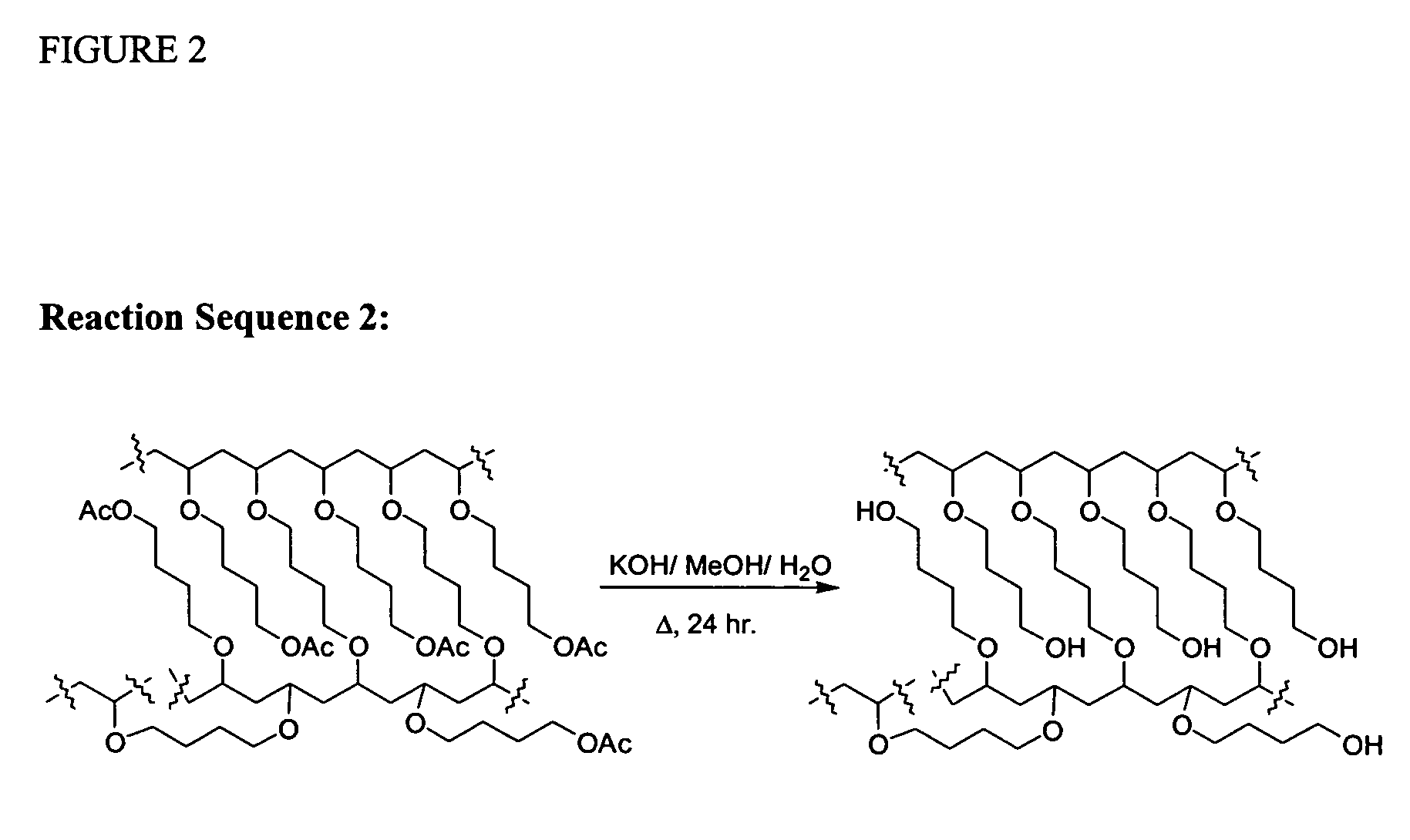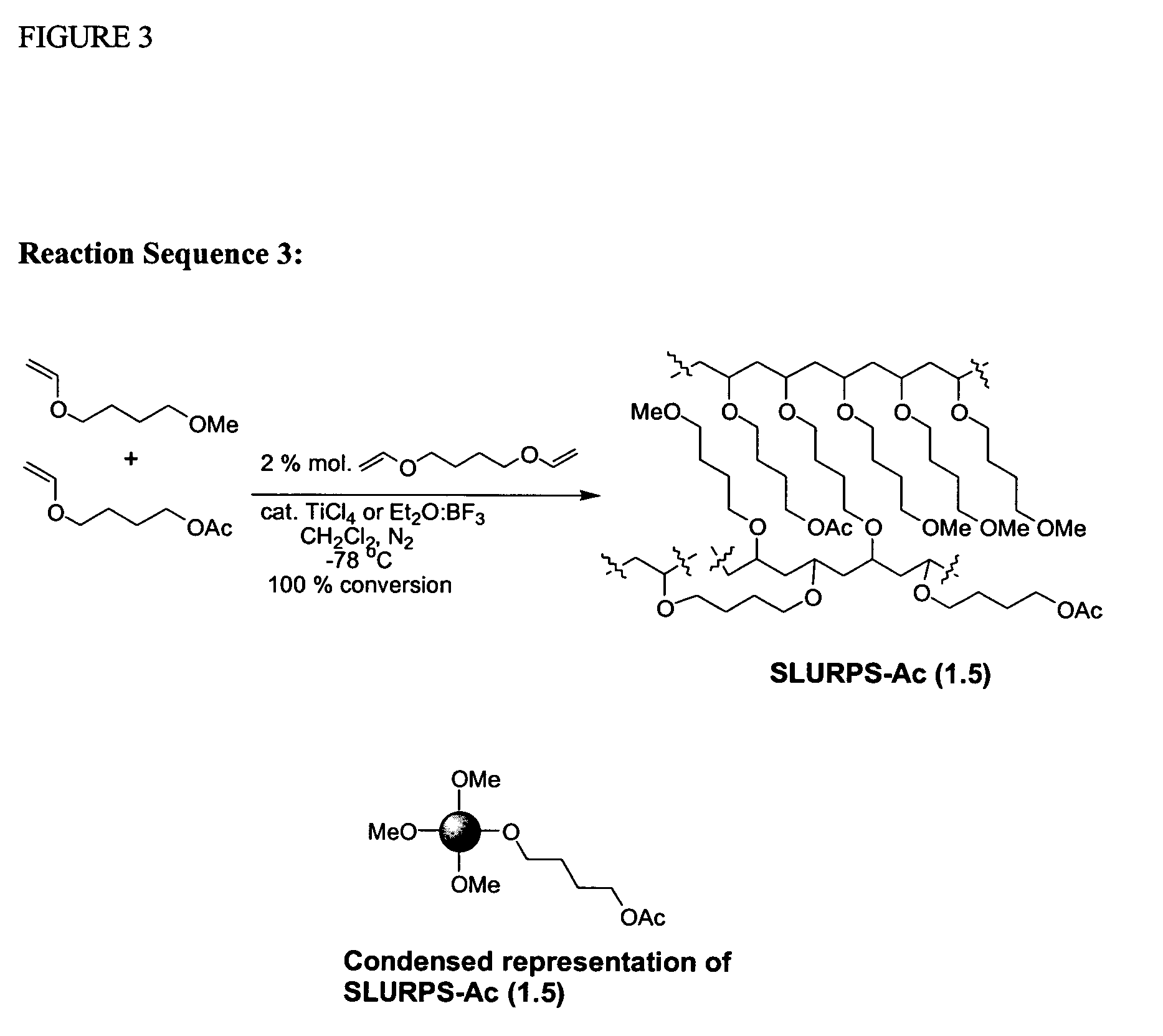Polyvinyl ethers
a polyvinyl ether and polyvinyl ether technology, applied in the field of polyvinyl ethers and their synthesis, can solve the problems of low solvent compatibility of polystyrene, dramatic reduction of loading levels from the ps, and inability to achieve significant change in swelling properties, etc., to achieve high loading levels, fast swelling kinetics, and high swelling degree
- Summary
- Abstract
- Description
- Claims
- Application Information
AI Technical Summary
Benefits of technology
Problems solved by technology
Method used
Image
Examples
example 1
Cationic Polymerisation of Butyl vinyl ether (BuVE) and 1,4-butanediol divinyl ether (BDDVE)
[0266]In a dried 50 ml round-bottomed flask under nitrogen, at −78° C., dried dichloromethane (10 ml), butyl vinyl ether (BuVE) (6.871 g, 68.60 mmol) and 1,4-butanediol divinyl ether (BDDVE) (200 mg, 1.40 mmol, 2% crosslinker) were added. TiCl4 (76 mg, 0.40 mmol) was added and the mixture was left standing under nitrogen for 2 hrs after gelation occurred. Afterwards, chilled NH3 (35% in H2O, 0.88 g / ml; 0.5 ml) in MeOH (4 ml) was added. The mixture was left to warm to room temperature, filtered and washed several times with dichloromethane, tetrahydrofuran, ethanol, acetone, ethyl acetate and diethyl ether. The final gel was dried under vacuum. The final solid is an off-white sticky solid that adheres to glass and plastics but not to metals. When swollen, the gel is very easy to handle and filter. Polymerisation under the same condition with Et2O:BF3 (57 mg, 0.40 mmol) provided a cleaner produ...
example 2
Cationic Polymerisation of (4-Methoxy)butyl vinyl ether (MeBDVE) and 1,4-butanediol divinyl ether (BDDVE)
[0269]In a dried 50 ml round-bottomed flask under nitrogen, at −78° C., dried dichloromethane (10 ml), MeBDVE (8.930 g, 68.60 mmol) and BDDVE (200 mg, 1.40 mmol, 2% crosslinker) were added. TiCl4 (76 mg, 0.40 mmol) was added and the mixture was left standing under nitrogen for 2 hrs after gelation occurred. Afterwards, chilled NH3 (35% in H2O, 0.88 g / ml; 0.5 ml) in MeOH (4 ml) was added. The mixture was left to warm to room temperature, filtered and washed several times with dichloromethane, tetrahydrofuran, ethanol, acetone, ethyl acetate and diethyl ether. The final gel was dried under vacuum. The final solid is an off-white sticky solid that adheres to glass and plastics but not to metals. When swollen, the gel is very easy to handle and filter. Polymerisation under the same condition with Et2O:BF3 (57 mg, 0.40 mmol) provided a cleaner product with the same characteristics. Co...
example 3
Cationic Polymerisation of (4-Acetoxy)butyl vinyl ether (AcBDVE) and 1,4-butanediol divinyl ether (BDDVE):
[0272]In a dried 50 ml round-bottomed flask under nitrogen, at −78° C., dried dichloromethane (10 ml), AcBDVE (10.852 g, 68.600 mmol) and BDDVE (200 mg, 1.40 mmol, 2% crosslinker) were added. TiCl4 (76 mg, 0.40 mmol) was added and the mixture was left standing under nitrogen for 2 hrs after gelation occurred. Afterwards, chilled NH3 (35% in H2O, 0.88 g / ml; 0.5 ml) in MeOH (4 ml) was added. The mixture was left to warm to room temperature, filtered and washed several times with dichloromethane, tetrahydrofuran, ethanol, acetone, ethyl acetate and diethyl ether. The final gel was dried under vacuum. The final solid is an off-white sticky solid that adheres to glass and plastics but not to metals. When swollen, the gel is very easy to handle and filter. Polymerisation under the same condition with Et2O:BF3 (57 mg, 0.40 mmol) provided a cleaner product with the same characteristics....
PUM
| Property | Measurement | Unit |
|---|---|---|
| temperature | aaaaa | aaaaa |
| temperature | aaaaa | aaaaa |
| temperatures | aaaaa | aaaaa |
Abstract
Description
Claims
Application Information
 Login to View More
Login to View More - R&D
- Intellectual Property
- Life Sciences
- Materials
- Tech Scout
- Unparalleled Data Quality
- Higher Quality Content
- 60% Fewer Hallucinations
Browse by: Latest US Patents, China's latest patents, Technical Efficacy Thesaurus, Application Domain, Technology Topic, Popular Technical Reports.
© 2025 PatSnap. All rights reserved.Legal|Privacy policy|Modern Slavery Act Transparency Statement|Sitemap|About US| Contact US: help@patsnap.com



